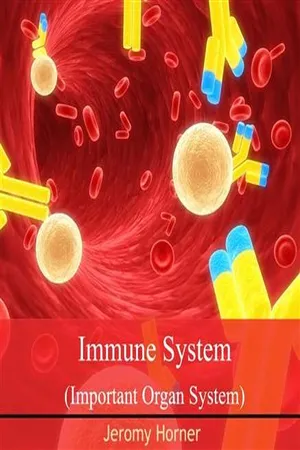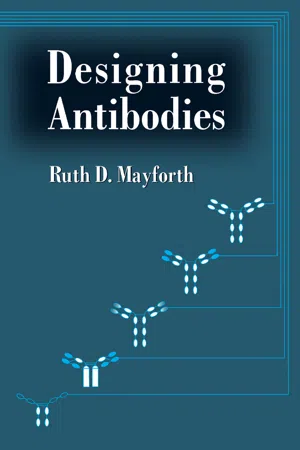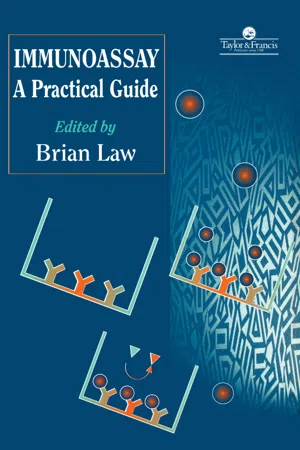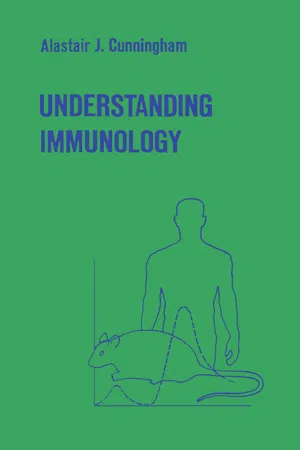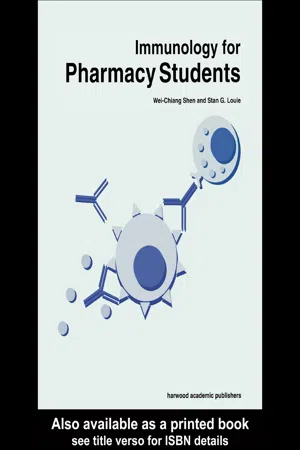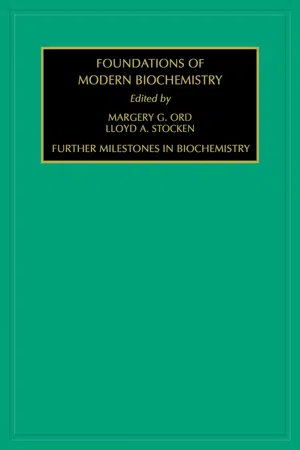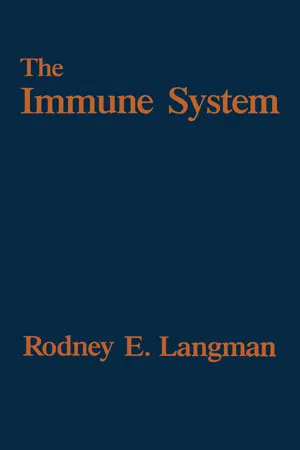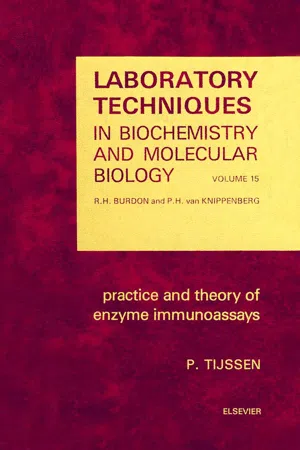Biological Sciences
Antibodies
Antibodies are proteins produced by the immune system in response to the presence of foreign substances, such as bacteria or viruses. They recognize and bind to specific molecules, known as antigens, to help neutralize or eliminate the foreign invaders. This targeted response is a key component of the body's defense against infections and diseases.
Written by Perlego with AI-assistance
Related key terms
1 of 5
11 Key excerpts on "Antibodies"
- No longer available |Learn more
- (Author)
- 2014(Publication Date)
- Orange Apple(Publisher)
________________________ WORLD TECHNOLOGIES ________________________ Chapter 1 Antibody Each antibody binds to a specific antigen; an interaction similar to a lock and key. An antibody also known as an immunoglobulin is a large Y-shaped protein used by the immune system to identify and neutralize foreign objects like bacteria and viruses. The antibody recognizes a unique part of the foreign target, termed an antigen. Each tip of the Y of an antibody contains a paratope (a structure analogous to a lock) that is specific for one particular epitope (that is equivalent to a key) on an antigen, allowing these two structures to bind together with precision. Using this binding mechanism, an antibody can tag a microbe or an infected cell for attack by other parts of the immune system, or can neutralize its target directly (for example, by blocking a part of a microbe that is essential for its invasion and survival). The production of Antibodies is the main function of the humoral immune system. Antibodies are produced by a kind of white blood cell called a plasma cell. Antibodies can occur in two physical forms, a soluble form that is secreted from the cell, and a ________________________ WORLD TECHNOLOGIES ________________________ membrane-bound form that is attached to the surface of a B cell and is referred to as the B cell receptor (BCR). The BCR, is only found on the surface of B cells and facilitates the activation of these cells and their subsequent differentiation into either antibody factories called plasma cells, or memory B cells that will survive in the body and remember that same antigen so the B cells can respond faster upon future exposure. In most cases, interaction of the B cell with a T helper cell is necessary to produce full activation of the B cell and, therefore, antibody generation following antigen binding. Soluble Antibodies are released into the blood and tissue fluids, as well as many secretions to continue to survey for invading microorganisms. - No longer available |Learn more
- (Author)
- 2014(Publication Date)
- Research World(Publisher)
________________________ WORLD TECHNOLOGIES ________________________ Chapter- 13 Antibody Each antibody binds to a specific antigen; an interaction similar to a lock and key. Antibodies (also known as immunoglobulins , abbreviated Ig ) are gamma globulin proteins that are found in blood or other bodily fluids of vertebrates, and are used by the immune system to identify and neutralize foreign objects, such as bacteria and viruses. They are typically made of basic structural units—each with two large heavy chains and two small light chains—to form, for example, monomers with one unit, dimers with two units or pentamers with five units. Antibodies are produced by a kind of white blood cell called a plasma cell. There are several different types of antibody heavy chains, and several different kinds of Antibodies, which are grouped into different isotypes based on which heavy chain they possess. Five different antibody isotypes are known in mammals, which perform different roles, and help direct the appropriate immune response for each different type of foreign object they encounter. ________________________ WORLD TECHNOLOGIES ________________________ Though the general structure of all Antibodies is very similar, a small region at the tip of the protein is extremely variable, allowing millions of Antibodies with slightly different tip structures, or antigen binding sites, to exist. This region is known as the hypervariable region . Each of these variants can bind to a different target, known as an antigen. This huge diversity of Antibodies allows the immune system to recognize an equally wide variety of antigens. The unique part of the antigen recognized by an antibody is called the epitope. These epitopes bind with their antibody in a highly specific interaction, called induced fit, that allows Antibodies to identify and bind only their unique antigen in the midst of the millions of different molecules that make up an organism. - eBook - ePub
Day's Veterinary Immunology
Principles and Practice
- Brian Catchpole, Harm HogenEsch(Authors)
- 2023(Publication Date)
- CRC Press(Publisher)
CHAPTER 8ANTIBODY STRUCTURE AND FUNCTIONDOI: 10.1201/9781003310969-8OBJECTIVES
At the end of this chapter, you should be able to:- Describe the basic structure of an immunoglobulin molecule.
- Describe how an antibody binds to an antigenic epitope.
- Define ‘affinity’ and ‘avidity’ as they relate to antigen binding by antibody.
- Describe the basic biological functions of antibody, following binding to its target antigen.
- List the five classes of immunoglobulin and describe their structure and function.
8.1 Introduction
Unlike T lymphocytes, that require antigen to be internalized, processed and presented to them by other cells, B lymphocytes express antigen receptors capable of recognizing surface epitopes of antigen in the extracellular fluid. When activated, B lymphocytes repurpose their surface antigen receptor to become a secreted molecule, known as antibody. Antibodies can be thought of as molecular ‘heat seeking missiles’ that can be fired out of lymphoid tissues to target, neutralize and destroy any pathogen expressing the antigen that stimulated their production. Thus, whereas the main ‘immunological output’ from CD4+ T lymphocytes are cytokines, the main output from B lymphocytes is antibody.An antigen may be defined as any substance capable of binding to a lymphocyte antigen receptor, typically stimulating an immune response. The immune system is usually ‘tolerant’ towards self-antigens (as we shall see in Chapter 14 ), although in some instances, autoAntibodies can be produced that may lead to pathology and autoimmune disease. The majority of foreign antigens are proteins and include those from infectious agents (e.g. viruses, bacteria, fungi, protozoa or helminths) or environmental substances (e.g. dietary proteins and pollens). The epitopes associated with these antigens may come from a peptide component (termed linear epitopes) or more commonly, a region on the surface of the protein brought about through its secondary, tertiary or quaternary structure (termed conformational epitopes). It is also possible for non-proteinaceous molecules to act as antigens (e.g. polysaccharides), although (as we shall see in the next chapter) the antibody response to these is not so potent or effective. It is also possible for inorganic substances and small organic molecules, including some chemicals and drugs, to stimulate an antibody response, although they can only do so when bound to a larger host carrier protein and are referred to as haptens (Figure 8.1 ). The clinical relevance of this phenomenon lies in the fact that some drugs may bind host proteins and inappropriately stimulate a drug reaction (Figure 8.2 - eBook - PDF
- Ruth Mayforth(Author)
- 2012(Publication Date)
- Academic Press(Publisher)
IDI Antibody Overview Introduction In this chapter, an overview of the humoral immune system and of antibody structure, function, and biosynthesis is presented. Its aim is to set the stage for a discussion of recent developments in antibody technology, which is the focus of the remainder of this book. The Humoral Immune System A number of features of Antibodies are particularly remarkable, making them amenable to a number of scientific and medical applications. Anti-bodies bind antigens (their ligands, which generally can be thought of as foreign macromolecules) with a high degree of specificity and can discriminate between two very closely related antigens. Another striking characteristic of Antibodies is their diversity. Human beings can produce at least 10 7 (and potentially even more than 10 11 ) Antibodies with different specificities. (The genetic mechanisms responsible for generating this vast repertoire are quite extraordinary and are described later in this chapter.) Antibody diversity is so great that virtually any foreign macro-molecule can be recognized. The diversity of Antibodies, combined with their specificity, makes them ideal biomolecular tools for scientific, diag-nostic, and therapeutic purposes. The human immune system can be divided into two major compo-nents: the humoral immune system and the cell-mediated immune sys-tem. Each human has about 2 x 10 12 lymphocytes (types of white blood cells). There are two kinds of lymphocytes, T cells and B cells, which are represented in approximately equal numbers. Both B cells and T cells express antigen-specific receptors on their cell surface, called the immunoglobulin receptor (IgR) and the T-cell receptor (TCR), respec-1 2 1 Antibody Overview tively. These receptors are clonally distributed—that is, all of the immuno-globulins that a given B-cell clone expresses are identical and have exactly the same specificity for antigen. When stimulated, B cells can also secrete their immunoglobulins. - Hafiz Ahmed(Author)
- 2017(Publication Date)
- CRC Press(Publisher)
193 5 Antibodies: Structures, Interactions, and Production Antibodies are produced primarily by plasma cells and the precursor B lymphocytes in response to the presence of foreign molecules (antigens) in the body. 1,2 The antibody response by the lymphocytes does not occur in all living organisms and is known only to vertebrate recognition systems. The circulating Antibodies bind to the specific antigen against which they are produced, and the resulting antigen-antibody complexes are removed from circulation by macrophages through phagocytosis. Antibodies are widely used in all areas of biological research, including clinical diagnostics, because of their specific interactions with antigens. Since antigens can specifically detect molecules in complex mixtures and in tissues, varieties of immu-nochemical techniques have been manipulated for investigation. 5.1 IMMUNE SYSTEM AND ANTIBODY RESPONSE The vertebrate immune system protects the body from infectious organisms. The surveillance of the immune system is served by circulating proteins and cells that recognize foreign materials and destroy the invaders. Vertebrates defend themselves against pathogens via two major mechanisms: innate immunity and adaptive response. Innate immunity is the first line of defense system and is mediated by cells that respond non-specifically to foreign molecules. Several systems such as phagocytosis by macrophages, secretion of lysozyme by bacterial cells, and cell lysis by natural killer cells contribute to innate immunity. However, the phagocytes of the innate immune system cannot recognize many pathogens and thus fail to eliminate infectious organisms. To overcome this problem, the lymphocytes of the adaptive immune system have evolved to provide protection from pathogens in a sophisticated way. Adaptive or acquired immunity is achieved in two ways: humoral and cell mediated.- eBook - PDF
Immunoassay
A Practical Guide
- Brian Law(Author)
- 1996(Publication Date)
- CRC Press(Publisher)
The immune system has many mechanisms and weapons it can deploy against the invading foreigner, but here discussion will be limited to the so-called humoral response. That is the system by which animals produce Antibodies which are exquisitely tailored to be capable of tightly binding specific foreign molecules. The following discussion will start by first considering the structure of the anti-body and then examine how the protein sequences of the polypeptides, which make up this antibody, are encoded in the animal's genetic material. Consideration will then be given to how the generation of Antibodies is controlled. To the immu-nologist this description will seem overly simplistic, but, we trust, not inaccurate. To the average reader it is hoped that it is comprehensible. Finally, the practical conse-32 Immunology and the Production of Reagent Antibodies quences of this .theory will be considered in relation to the production of Antibodies for immunoassays. The meaning of some of immunology's more prosaic language will be explained in the text, for other unfamiliar terms the reader is referred to the glossary. Antibody structure The basic antibody unit consists of four polypeptide chains: two identical heavy chains, which are linked by one or more disulphide bridges, and two identical light chains, each of which is paired with a heavy chain to form two identical antigen binding sites (Figure 4.la) (Edelman et al., 1969). In some classes of antibody further polymers are formed from this basic four-chain unit and other polypeptide chain(s). - eBook - PDF
- Alastair J. Cunningham(Author)
- 2012(Publication Date)
- Academic Press(Publisher)
2 The Reaction of Antibody with Antigen There is a circular definition at the heart of immunology. Antigen is whatever stimulates the production of antibody, and Antibodies are molecules whose pro-duction is induced by antigen. Like many concepts in this discipline and in other branches of biology, the terms antigen and antibody are difficult to define in a simple way, but their meaning becomes clearer with time and thought. For the present, we can say that antigens are any substances which, when introduced into an animal, provoke a specific immune response. This response is often measured as antibody capable of reaction with the antigen, although other types of specific immune response (e.g., cellular, Chapter 9) are also seen. Anti-gens may be particulate, e.g., bacteria, viruses, erythrocytes from other species, or soluble, e.g., proteins, polysaccharides, or combinations of proteins and polysaccharides together or with lipids. Nucleic acids and lipids by themselves are usually not antigenic. We apply the adjective immune equally to reactions against living or nonliving materials. Substances do not normally act as antigens unless they have a molecular weight of more than about 5,000-10,000 (the reasons for this will emerge later), and as a broad generalization, immuno-genicity, or the ability of an antigen to stimulate a response, increases with molecular size. Particles such as bacteria, red blood cells, or aggregated proteins are often the strongest antigens. Substances derived from living organisms are usually only antigenic in different, and preferably genetically distant, species. A mouse will make antibody very well to sheep erythrocytes, rather poorly to rat erythrocytes, and usually not at all to its own erythrocytes. The immunogenicity of a molecule is not an absolute property but a relative one: it depends on the animal in which it is tested. 9 - eBook - PDF
- Wei-Chiang Shen, Stan G. Louie(Authors)
- 2019(Publication Date)
- Routledge(Publisher)
2 Antibodies and Complement As described in Chapter 1, the innate immune response involves various types of cells such as granulocytes and macrophages, as well as many soluble factors such as complements and cytokines. These cellular and humoral factors play the role of first line defense to protect the body from infections. The innate immune response is usually inefficient due to its non-specificity and simplicity. However, upon contact with infectious agents, the immune system can slowly develop another response, i.e., the acquired immune response, which is adaptive to the specific challenge. Therefore, the acquired immune response is more effective in fighting selective infectious agents because of its specificity. Similar to the innate immune response, the acquired immune response can also be divided into cellular immunity and humoral immunity. In this chapter, two of the most important factors, i.e., Antibodies and complement, involved in humoral immunity of acquired immune response will be discussed. Antibodies—The Center of the Humoral Immunity Antibodies are a group of glycoproteins which are present in serum, as well as in almost all physiological fluids of vertebrates, as immunoglobulins (Igs). The simplest structure of an immunoglobulin molecule consists of two identical short polypeptide chains, the light chains, and two identical long polypeptide chains, the heavy chains, interconnected by several disulfide bonds. All Antibodies consist of either κ or λ light chain polypeptides; however, within a single antibody molecule only one type of light chain polypeptide occurs. Furthermore, heavy chain polypeptides within a single antibody molecule are all identical; thus the structure of an antibody molecule is highly symmetrical as shown in Figure 2.1. The two amino terminal regions from one light chain and one heavy chain form a binding site for the antigen. These amino terminal regions of light chains Table 2.1. - eBook - PDF
- M.G. Ord, L.A. Stocken(Authors)
- 1997(Publication Date)
- Elsevier Science(Publisher)
Eventually, the term immunoglobuUn was introduced to include the set of all proteins that share antigenic determinants, and hence essential structural features with Antibodies (Ceppellini et al, 1964). (An antigenic determinant, or epitope in current terminology, is the portion 292 LISAA.STEINER of an antigen that makes contact with the combining site of a particular antibody; an antibody, like any protein, can also function as an antigen and so has a number of epitopes.) The term immunoglobulin is preferentially used when emphasis is on the antibody as a protein, regardless of its antigen-binding activity. The Papain Fragments In the 1950s the pioneering work of Fred Sanger^ in working out methods to establish the amino acid sequence of insulin (Sanger and Tuppy, 1951; Sanger and Thompson, 1953) ushered in an era of rapid advances in the determination of the sequences of proteins. Rodney Porter^^, a Ph.D. student of Sanger, became interested in the question of the chemical basis for antibody activity. At that time, the only proteins whose sequence had been determined (insulin, ribonuclease, lysozyme) were at least an order of magnitude smaller than antibody molecules. An even more formidable problem was that different preparations of antibody, known to bind to the same antigenic determinant, varied measurably in molecular properties (e.g., as demonstrated by electrophoresis) and were impossible to fractionate into homogeneous constituents. Nevertheless, the heterogeneity did not obscure the substantial similarity among all immunoglobulin molecules, similarity that had contributed to Pauling's formulation of the variable folding model of antibody specificity. The major distinction among Antibodies was in their recognition of different antigens, not in their overall molecular structure. - eBook - PDF
- Rodney Langman(Author)
- 2014(Publication Date)
- Academic Press(Publisher)
Β cells and immunoglobulins Immunoglobulins are effector molecules produced and secreted by Β cells. These effector molecules diffuse throughout the body fluids to provide specific protection against extracellular parasites (antigens). One of the first uses of immune intervention in medicine was the pas-sive transfer of serum from an immune convalescent individual to an infected nonimmune recipient. The passive transfer of immunity is, in fact, a normal occurrence; maternal immunoglobulin is transferred to the neonatal offspring to provide protection against pathogens that the mother has survived. Passive maternal immunity allows the neonatal immune system to complete its development and eventually provide full protection. In some species (e.g., man and mouse), im-munoglobulin crosses the placenta, and in others (e.g., cows and pigs), immunoglobulin is secreted in the colostrum; in birds, im-munoglobulin is added to the egg before it is laid. In this chapter, Β cells and immunoglobulins are considered under six general headings. The first two sections deal with basic structural information, and the remaining four show how an evolu-tionary logic links some of the unique properties of immunoglobulins in a simple framework based on their immune effector functions. I. Immunoglobulins as proteins Immunoglobulins are the antigen-binding proteins that individual Β cells secrete into serum. The immunoglobulin molecule has two functionally distinct parts; one determines antigen binding 62 Chapter 4. Β cells and immunoglobulins specificity, the other links antigen binding to the effector functions that eventually cause the bound antigen to be eliminated. a. Historical background The two parts of immunoglobulins were demonstrated experimental-ly by the finding that rabbit immunoglobulin could be cleaved by the proteolytic enzyme papain into two fragments, one termed the F(ab)2 (fragment antigen binding), the other termed the Fc (fragment crys-tallizable). - eBook - PDF
- P. Tijssen(Author)
- 1985(Publication Date)
- Elsevier Science(Publisher)
43 CHAPTER 5 Production of Antibodies An understanding of the basic principles of the biology of the immune response and its regulation is a prerequisite for the successful experi- mental production of Antibodies. This enables the investigator to induce a vigorous antibody production, instead of obtaining highly unpredictable results 'and undesired effects, such as tolerance (im- mune unresponsiveness). Some highly recommended reviews are Eisen (1980), Roitt (1980), Benacerraf and Unanue (I98 l), Golub (I98 I ) , and Klein (1 982). 5.1. Biology and regulation of the immune reponse 5.1.1. Primary and secondary immune response Humoral immune responses can be divided into two types: primary and secondary responses, which reflect the cellular dynamics of the immune system and the immune state of the host. A primary response is caused by the first exposure to a given immunogen and results in the appearance of predominantly IgM Antibodies after a relatively long lag period, followed by a peak and a decline of antibody forma- tion. After a lapse of time, another exposure to the immunogen produces a quite different, secondary response which is characterized by a shorter lag period, a stronger response with predominantly IgG Antibodies and, after a peak has been reached, a slower decrease. 44 PRACTICE & THEORY OF ENZYME IMMUNOASSAYS Moreover, Antibodies of the secondary response usually have a higher affinity which may increase even more with time (maturation, see Section 8.5). The immune system stores information of the first contact with the immunogen (‘priming’) in so-called memory cells. Some immunogens cause no secondary responses (only IgM) and the immune response to these immunogens is not helped by T cells, as to other immunogens. These T-independent immunogens have the capacity to stimulate directly B lymphocytes, probably because they often have repeating structures, such as in the case of polysac- charides from bacterial origin.
Index pages curate the most relevant extracts from our library of academic textbooks. They’ve been created using an in-house natural language model (NLM), each adding context and meaning to key research topics.

